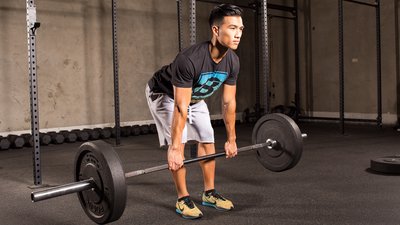Deadlifting always looks so simple: You just bend over and pick up an object off the floor, right? While any old form is fine when picking up a penny, picture-perfect technique becomes imperative when heavy weights are involved. If you mess up the lift, the targeted muscles won't get worked like they should. More ominously, you could do serious damage to the disks in your spine. And once damaged, those disks can't really be fixed, leading to problems that can forever alter your quality of life.
No one is born knowing how to do this movement correctly, so very few people get it right, at least in the beginning. If you're new to deadlifting or haven't mastered the form, it all starts with learning how to hip hinge.
Let's take an in-depth look at this basic movement pattern, cover a few drills that'll allow you to nail the form, and then talk about the one exercise that best prepares you for this movement.
What's a Hip Hinge?
Picture a lawn chair folding in half at the hinges. If all is in working order, there's no movement in the back or the seat—each remains rigid as the chair closes on itself.
Your body's hip hinge works the same way. Compare your legs to the seat and your torso to the back of the chair. Once the knees unlock, each half remains relatively rigid and still while the hips rotate (the hinge). There's tension on each side of the joint, which keeps the torso locked and the legs appropriately stiff. The joint simply rotates to open and close.
That's the hip hinge. Everything above the hip joints remains still, and the legs move only enough to appropriately unlock the knees.
Learning How to Hip-Hinge
The hip hinge starts with your base and "dialing" your feet.
Dialing sets your base and keeps your weight centered in the middle of your feet. This keeps you from transferring your weight too far back onto your heels or too far forward onto your toes. Keeping the weight centered lets you hip hinge smoothly while properly using your hip and core muscles to keep you stabilized and balanced.
To dial, press your big toe, pinky toe, and heel into the floor—you should feel a "triangle" begin to form. Once you've done this, screw your foot into the ground by twisting your knee out. You'll feel the arch of your foot rise and all of the muscles get tight, from your foot through your calf and thigh to your hip. You now have a solid base.
Now that you have your base set, remember three letters: T.R.D. It's your new hip-hinge performance mantra. T stands for "tall" and "tight": the position you'll begin in and hold with your upper body throughout the movement. R stands for "reach": what you'll do with your hips until you feel tension in your hamstrings. D stands for "drive": what you'll do into the ground until you return to the starting tall-and-tight position.
Ingrain this mantra in your head while hinging, and visualize yourself maintaining a relatively stiff upper and lower body the entire time. Do this, and you'll develop a strong, efficient hip hinge, like the one demonstrated in this video.
Strengthening the Hinge
Hinging is a hip-dominant pattern; the hips should do the majority of the work and moving. Once you've got the pattern down pat, you'll load it to make it strong and keep it fresh in your catalog of basic training movements.
Here are a few exercises that keep your hip hinge solid while also making it strong.
Cat-Cow and Kneeling Handcuff Hinge
Sometimes you need start with a little hinge maintenance or put yourself in positions that help you learn to hinge better. A big problem folks face while hinging is learning to keep their upper body rigid while still focusing movement at the hips. This is often because they have poor awareness of the difference between their hips moving and their spine moving. Supersetting the cat-cow and kneeling handcuff hinge helps clear that up while also serving as a great warm-up.
The cat-cow moves the spine through the biggest range of motion possible. This might seem counterintuitive, because you're supposed to keep the upper body rigid and the spine as still as possible while hip hinging, but the cat-cow creates spinal awareness that's necessary for keeping it still while the hips move. If you don't understand the difference between moving your hips and moving your spine, there's no way to separate their movements when you need to. The cat-cow teaches you where your spine is.
The kneeling handcuff hinge teaches you to hinge without having to worry about much else. Kneeling removes the knees and ankles from the movement, and holding a kettlebell behind the butt locks in the upper body while also giving the hips a target to reach for. All there is to do is stay tall and tight while creating tension by trying to "rip the kettlebell in half," reaching your butt into the kettlebell and driving your knees into the ground to finish. It quickly teaches you how to move only at the hips.
Increase the Difficulty: Romanian Deadlift (RDL)
You've learned the difference between the hips and the spine and learned how to hinge on our knees. Now it's time to stand on your feet.
While most lifters strive to build a huge conventional deadlift with the weight starting on the floor, the Romanian deadlift instead builds strength starting in the top position. Why is this important for a big floor-up deadlift? First, it makes the hinging pattern strong. The ability to hinge well with moderate-to-heavy weight helps the body and the brain continue to hinge well.
Your body is often counterintuitive; doing things in reverse often makes us better at them. So training the ride down with the RDL makes you better at the conventional ride up. RDLs also build general low-back, lat, hip, and hamstring strength, all of which carries over to deadlifting from the floor.
RDL well by getting tall and tight (standing as tall as possible, bracing the abs and lats), dialing to keep your weight centered over the middle of your feet, and reaching your hips back until you feel your hamstrings get tight. Drive the floor away to ascend back to the starting position. All the while, keep the bar pulled back into your legs. Notice in the video that the hips and knees move together. The hips just move more.
Now You're Ready to Deadlift
A solid hinge is the base from which strong conventional deadlifts are built. Get your hinge right with the cat-cow and the kneeling handcuff hinge. Then, make it strong with RDLs. You'll give yourself the skills and strength you need for better deadlift training!

